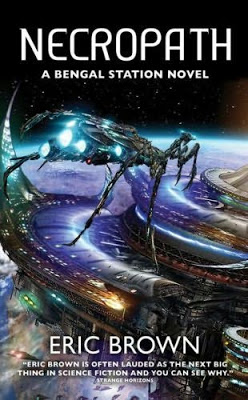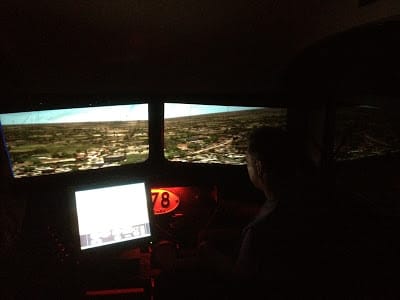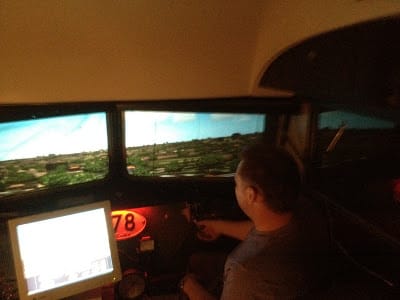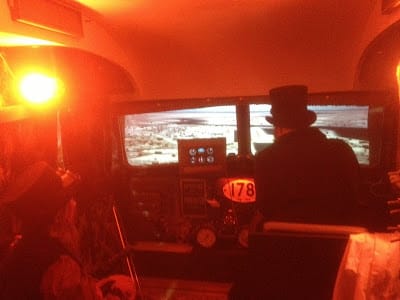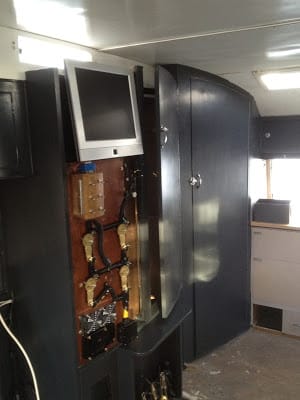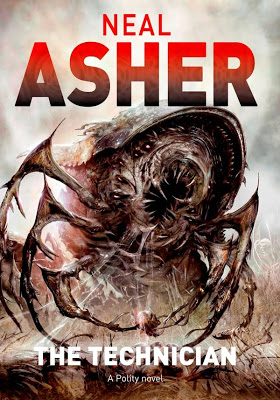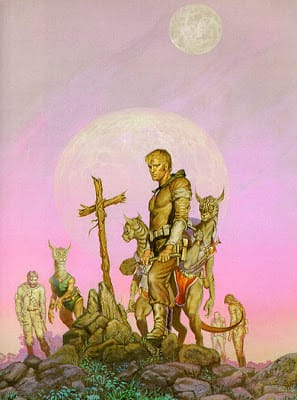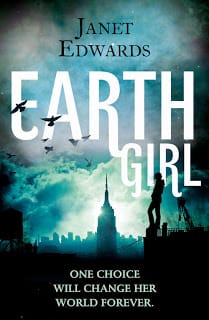I remember Eric Brown from Interzone back in the eighties, with his short story The Time-Lapsed Man being a particular highlight. Like many other writers I enjoy now his name stuck in my mind (Alastair Reynolds, Ian M Banks) but haven’t really read any of his books. So, walking into Waterstones and seeing his name and this cover I just picked up Necropath and bought it. I’m glad I did. Here we have the void ships of his short stories, the massive Bengal Station space port, intrigue, murder, an alien monster and a telepathic customs official whose outlook reminds some of Silverberg’s Dying Inside – everything the hardened SF addict wants. Time now for me to a take a look at all the other books he’s written which, for some inexplicable reason, just seemed to have passed me by. Recommended.
Tag: Science Fiction
Waterstones Romford
Steam Punk Zeppelins!
Here’s a little taste of what some fans get up to when you’re not keeping a careful eye on them. I’ve been asked to name a starship simulator and to provide some tongue in cheek names for some airships, which I’m glad to do. The starship simulator could so easily be Schrodinger’s Box out of The Engineer (esp. when you look at that caravan). I’ll hand over to Paul Mackay now:
HMAS Absence of Gravitas is a 1969 Carlight Cassetta caravan with a ‘victorianised’ interior. We have used a back projection system to project from outside onto the interior front windows so it actually looks like you are in the gondola of an airship with the horizons:
The control linkages use miniature potentiometers to feed control inputs into the sim which runs into a PC running Flight Sim 2004 with an airship mod. There is a navigator’s station (uses a real map as location is real world correct and can plot routes using it). The engineers panel has 4 separate throttles which can all be set independently, useful if you want to chuck in a failure or fire scenario. The helmsman controls the nose pitch and engine angle (as they rotate up and down in modern airships). There is usually a captain as well.
Big brother is moving towards constructing a second sim that will be able to run several different software packages – i.e submarine, starship or airship. The problem with the caravan sim is that we can’t bring it indoors whereas the second sim (that we would like you to name) comes in collapsible sections that can be erected in pieces.
The second will run a package called Artemis http://www.artemis.eochu.com/ which is a multi station starship bridge simulator hoping you might be able to come up with a name for the starship sim. (see diagram above, its only half finished).
As I said earlier, we we run a gift shop at shows…we make and sell merchandise related to the sim – mostly my steampunk jewellery but also things like pewter cast airship keyrings, badges etc. We are also hoping to commission a poster of lots of scale drawings of various ‘ships of the line’ – all imaginary airships as if we had this whole alternative historical backstory, with the ‘Absence of Gravitas’ as just one of the fleet. We were wondering if you wanted to give us a few tongue in cheek bombastic airship names as well – think I might have to call one of them ‘Penny Royal’ if you don’t mind.
Anyway, just thought you might be interested in the sort of stuff your fans get up to when we aren’t waiting for the next book.
We have some masters getting 3D modelled in Holland at the mo, then we make silicon moulds from them and use them to cast models in pewter to sell to punters. The sims have to pay their way in the diesel etc. to get it to shows, we don’t profit much but it pays its way.
Regards and can’t wait for more writings
Paul
Writing Update
Okay, that’s sorted. Before Christmas I received the version of Jupiter War, edited by Peter Lavery, along with some helpful structural/character notes from Bella Pagan. Peter was the editorial director of Pan Macmillan and Tor who originally took me on. He’s now retired from Macmillan, but continues doing what he loves, which is using his scary pencil to puncture inflated writer’s egos, while Bella is a senior commissioning editor for Tor/Pan.
Peter’s editing I am accustomed to. It is generally along the lines of ‘this is a clearer way of expressing what you want’. He also picks up on repetitions and grammatical errors, selects out sections he designates ‘unnecessary?’, and returns a typescript in which I never find a page lacking corrections. After I’ve gone through his stuff the word count has usually increased by a few thousand words. But I have to add that what I take on board is completely down to me. When, many years ago now, he first returned the typescript of Gridlinked with pencilled-in corrections, he also sent an eraser – my choice.
Bella’s notes I looked at with a slight sinking sensation in my gut because structural changes can be sticky, and a simple note concerning the behaviour of a character can involve checking the same throughout the entire book. However, I’m well aware of the danger of authorial arrogance. An established author can think he knows best and the result of that can be big fat books full of boring waffle. I therefore took the bit between my teeth and dived in. She was right, of course, and I made many of the changes she suggested.
Now it’s time to get back to Penny Royal. I was on book three before Christmas but have now gone back to read through from the start of book one, correcting and altering along the way. I need to add some stuff concerning a black hole, I’m considering shifting two sections at the start of book one to the beginnings of the ensuing two books, but mostly I need to sink myself back into the whole thing and remind myself where I was at. Having gone this route before, I know that I won’t read all the way through. At some point, within the next few days, I’ll get bored with that and leap ahead to start writing afresh. That’s all for now.
Darpa's LS3
I just love this. More about it here on Physorg.
Amazon 99p Deal
Get it while it’s hot! You can buy a copy of The Technician for you Kindle for 99p today!
Exhausted by Doom-mongers.
I watched the TV series The Secret of Crickley Hall – last episode last night – and though I enjoyed it I couldn’t really engage with it. I got the same feeling watching it as I got from watching Woman in Black, which is that though it was entertaining I could not suspend disbelief. When I was younger I could watch this sort of stuff and feel a little bit spooked – two that spring to mind are The Haunting (the original version) and The Entity – but my opinions about the supernatural have hardened over the years and now I simply cannot believe in ghosts. The films and the fiction haven’t really got any worse, if anything some have got better, but I have changed.
By this route I come to those who keep launching assaults on science fiction. I’d call it self-flagellation because often these people are ‘in’ the SF world, but for the fact that many of those attacking don’t actually write the stuff. Science fiction is dying or dead, it’s no longer relevant because of the accelerated pace of technological change (how could it not be more relevant?), and the latest one ‘science fiction is exhausted’ – based on some Best SF collections so generalizing from the specific and ignoring Sturgeon’s Law.
Moving on to the stuff about it being relevant in the rapidly changing world: How can someone read recent books like Windup Girl or Quantum Thief and dismiss them as irrelevant? Who says a requisite of SF is that it has to be relevant? The job of a writer is first to write books and then to sell them. The main requisite of the latter is to make them entertaining, and for them to be that, for an SF reader, requires a good story that can suspend disbelief, world building, the zing of technology and science and that essential sensawunda.
Now let’s go back to ‘science fiction is dying, or dead’ (yawn). I’ve been here before with this here, here and here but the neatest way of putting this in perspective is via a link provided by Gary Farber in response to my, “I’m betting there was some plonker declaring the death of SF the moment Sputnik beeped or just after Neil Armstrong stepped onto the Moon.”
Who Killed Science Fiction? won the Hugo Award for Best Fanzine in 1961. The Fifties were rife with talk about the death of science fiction, and Earl Kemp’s symposia of so many sf pros and prominent fans summed it all up.
If science fiction was dead back in the 50s and 60s, why does it still seem so mobile now? If it was dying back then why isn’t it dead now? And really, science fiction is nowhere as near as exhausted as the perpetual wanking on about its decline.
Let’s have a little list: Iain M Banks, Alastair Reynolds, Peter F Hamilton, Adam Roberts, Ted Chiang, C J Cherryh, Peter Watts, Gary Gibson, Jon Courtenay Grimwood, Ken McLeod, Neil Gaiman, Paolo Bacigalupi, Jeff Noon, Kim Stanley Robinson, Greg Egan, Hannu Rajaniemi, Stephen Baxter, Sheri S. Tepper, Elizabeth Bear, Paul J. McAuley, Ian McDonald Greg Bear, David Brin, Orson Scott Card, Cory Doctorow, John Meaney, John Scalzi, Kristine Kathryn Rusch … I could go on. Now, as far as I know these are all still alive (though I don’t keep up with my Ansible obituaries) and are still producing stuff people want to read. Whether or not they are exhausted I don’t know, whether or not the fiction they produce is dying, exhausted or dead I leave to you to decide.
All these attacks on science fiction are utterly subjective and ultimately pointless because, in the end, they tell us more about the one writing than the fiction they are writing about (much like many reviews). Perhaps they loved science fiction once and could suspend disbelief, and now, just like me watching Crickley Hall, it simply is not pressing the right buttons any more. Maybe they have changed.
Because you feel you have read it all before doesn’t mean others have and equally, just because you might have become more discerning and sophisticated doesn’t mean others are. Just because you are suffering ennui and have lost the credulity and optimism of youth doesn’t mean others have. Just because you are inured to wonder, and can no longer find that vital sensawunda, doesn’t mean it has disappeared, dried up, been exhausted.
Maybe the next time somebody feels the urge to write something about the terminal decline of SF, they should consider that the ‘crisis’ is in the eyes that behold, and take a long hard look at themselves first.
Penny Royal III Started
Well, checking my journal I see that I began writing Penny Royal II on the 19thof July and finished it to first draft on 27th November so, four months, one week and one day. Of course I haven’t completely finished it just as I haven’t completely finished Penny Royal I. Right now I have to go back to that first book to write in some stuff about a world due to be swallowed by a black hole to make some other stuff in Penny Royal III work. I also have alter a particular character all the way through – in this case an assassin drone fashioned in the shape of a prador parasite (I’ve mentioned Riss before – this drone looks like a translucent cobra with a third eye on top of its head, small limbs underneath that head and an ovipositor in its tail). Similar alterations will ensue as I write Penny Royal III (I’m a thousand words in at the moment) and thereafter will come loads of editing before I send these books to Macmillan, then a couple of more rounds of editing after I get it back.
This picture is here because this is what Penny Royal sometimes looks like. I was going to tray a mish-mash of this and the Curiosity Rover confronting each other, but don’t have the time. Hey, if anyone fancies mucking about with an art program I’d love to see a picture of Penny Royal in some alien landscape. Just to help in that respect (and to tease you all):
The buy was going down, badly, because the shits involved had decided that their large amounts of weaponry gave them a bargaining advantage. It was all about to turn into a nasty fire fight when the other side’s repairman turned up, and then it turned into a nightmare. The meet had been in a valley on a heavy gravity world where plants grew iron hard and close to the ground and where most humans wore motorized suits. Blite, as he prepared himself to give the order blow the sled the thrall tech sat on, and open fire, had looked up. On the ridge above, a flower had bloomed: a giant black thistle head atop a stalk of braided silver snakes. He stared at it in shock as, like a slow black explosion it came apart, its individual spikes turning as they sped away to point down into the valley, all settling to hang still in the air – a wall of daggers woven through with silver lace.
‘Penny Royal!’ one of the opposition called, gazing at Blite with a superior smile.
But before all of that there’s other work to be done, like going through the copy edits of the Night Shade Books version of The Departure. And, of course, here’s a reminder
Night Shade Books are publishing The Owner Trilogy in the US and have scheduled The Departure for publication Feb 5, 2013 with Zero Point following May 7, 2013 and Jupiter War September 3, 2013 (catching up with publication of that last book in Britain). Nicely keying into that my short story The Other Gun will be appearing in Asimov’s April/May issue that year with, of course, mention of these books in attached biog. It should be an interesting year with those three books slamming into the American market in rapid succession. In essence this should work as quite a profile-raising exercise.
So, where was I going with this? Oh yeah: it may have taken me just over four months to get Penny Royal II to first draft, but please don’t start expecting me to produce 3 books a year. In fact, if I do start finding myself at a bit of a loose end I’ll be producing more stories like the one in Asimov’s above, or maybe taking a look at my old fantasy trilogy. Or I may even take a holiday!
Cellweld – TM
In my books I often do surgical scenes in which cell welders and bone welders are used. It seems to me that I can now properly describe and extrapolate that technology. But of course now I must think in terms of reprinting missing limbs and organs, or even reprinting an entire body. Growing such stuff in the good old sfnal amniotic tank is old now.
The 2D structures being printed with the bio-ink enables exquisite control over cell distribution and this already presents exciting opportunities to improve drug screening and toxicology testing processes. Building on this, 3D bio-printing, with which patient-specific tissue replacements could be fabricated, is within the grasp of researchers.
Earth Girl – Janet Edwards
2788. Only the handicapped live on Earth. While everyone else portals between worlds, 18-year-old Jarra is among the one in a thousand people born with an immune system that cannot survive on other planets. Sent to Earth at birth to save her life, she has been abandoned by her parents. She can’t travel to other worlds, but she can watch their vids, and she knows all the jokes they make. She’s an ‘ape’, a ‘throwback’, but this is one ape girl who won’t give in. But can she prove to the norms that she’s more than just an Earth Girl?
I’m not entirely sure why but I found an uncorrected proof copy of Earth Girl in the pile of post waiting for me when we got back from Crete. Noting that it was ‘young adult’ I was a bit reluctant, but then I had a go anyway. It’s told in first-person, is easy reading which, for obvious reasons, rather reminds me of the ‘Twilight’ books, and I enjoyed it. This I reckon would be the perfect gift for teenage relative you want set on the slippery slope to the damnation of enjoying science fiction.
